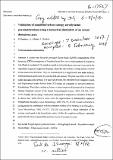| dc.contributor.author | Ramirez, N. | |
| dc.contributor.author | Afshari, Afshin | |
| dc.contributor.author | Norford, Leslie Keith | |
| dc.date.accessioned | 2021-11-15T15:37:21Z | |
| dc.date.available | 2021-09-20T17:30:06Z | |
| dc.date.available | 2021-11-15T15:37:21Z | |
| dc.date.issued | 2018-02-27 | |
| dc.identifier.uri | https://hdl.handle.net/1721.1/131745.2 | |
| dc.description.abstract | Abstract
A steady-state Reynolds-averaged Navier–Stoke computational fluid dynamics (CFD) investigation of boundary-layer flow over a major portion of downtown Abu Dhabi is conducted. The results are used to derive the shear stress and characterize the logarithmic region for eight sub-domains, where the sub-domains overlap and are overlaid in the streamwise direction. They are characterized by a high frontal area index initially, which decreases significantly beyond the fifth sub-domain. The plan area index is relatively stable throughout the domain. For each sub-domain, the estimated local roughness length and displacement height derived from CFD results are compared to prevalent empirical formulations. We further validate and tune a mixing-length model proposed by Coceal and Belcher (Q J R Meteorol Soc 130:1349–1372, 2004). Finally, the in-canopy wind-speed attenuation is analysed as a function of fetch. It is shown that, while there is some room for improvement in Macdonald’s empirical formulations (Boundary-Layer Meteorol 97:25–45, 2000), Coceal and Belcher’s mixing model in combination with the resolution method of Di Sabatino et al. (Boundary-Layer Meteorol 127:131–151, 2008) can provide a robust estimation of the average wind speed in the logarithmic region. Within the roughness sublayer, a properly parametrized Cionco exponential model is shown to be quite accurate. | en_US |
| dc.publisher | Springer Netherlands | en_US |
| dc.relation.isversionof | https://doi.org/10.1007/s10546-018-0345-7 | en_US |
| dc.rights | Creative Commons Attribution-Noncommercial-Share Alike | en_US |
| dc.rights.uri | http://creativecommons.org/licenses/by-nc-sa/4.0/ | en_US |
| dc.source | Springer Netherlands | en_US |
| dc.title | Validation of Simplified Urban-Canopy Aerodynamic Parametrizations Using a Numerical Simulation of an Actual Downtown Area | en_US |
| dc.type | Article | en_US |
| dc.contributor.department | Massachusetts Institute of Technology. Department of Architecture | en_US |
| dc.eprint.version | Author's final manuscript | en_US |
| dc.type.uri | http://purl.org/eprint/type/JournalArticle | en_US |
| eprint.status | http://purl.org/eprint/status/PeerReviewed | en_US |
| dc.date.updated | 2020-09-24T20:33:02Z | |
| dc.language.rfc3066 | en | |
| dc.rights.holder | Springer Science+Business Media B.V., part of Springer Nature | |
| dspace.embargo.terms | Y | |
| dspace.date.submission | 2020-09-24T20:33:02Z | |
| mit.license | OPEN_ACCESS_POLICY | |
| mit.metadata.status | Publication Information Needed | en_US |
